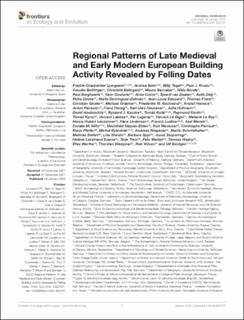| dc.contributor.author | Ljungqvist, Fredrik Charpentier | |
| dc.contributor.author | Seim, Andrea | |
| dc.contributor.author | Tegel, Willy | |
| dc.contributor.author | Krusic, Paul J. | |
| dc.contributor.author | Baittinger, Claudia | |
| dc.contributor.author | Belingard, Christelle | |
| dc.contributor.author | Bernabei, Mauro | |
| dc.contributor.author | Bonde, Niels | |
| dc.contributor.author | Borghaerts, Paul | |
| dc.contributor.author | Couturier, Yann | |
| dc.contributor.author | Crone, Anne | |
| dc.contributor.author | van Daalen, Sjoerd | |
| dc.contributor.author | Daly, Aoife | |
| dc.contributor.author | Doeve, Petra | |
| dc.contributor.author | Domínguez-Delmás, Marta | |
| dc.contributor.author | Edouard, Jean-Louis | |
| dc.contributor.author | Frank, Thomas | |
| dc.contributor.author | Ginzler, Christian | |
| dc.contributor.author | Grabner, Michael | |
| dc.contributor.author | Gschwind, Friederike M. | |
| dc.contributor.author | Haneca, Kristof | |
| dc.contributor.author | Hansson, Anton | |
| dc.contributor.author | Herzig, Franz | |
| dc.contributor.author | Heussner, Karl-Uwe | |
| dc.contributor.author | Hofmann, Jutta | |
| dc.contributor.author | Houbrechts, David | |
| dc.contributor.author | Kaczka, Ryszard J. | |
| dc.contributor.author | Kolář, Tomáš | |
| dc.contributor.author | Kontic, Raymond | |
| dc.contributor.author | Kyncl, Tomáš | |
| dc.contributor.author | Labbas, Vincent | |
| dc.contributor.author | Lagerås, Per | |
| dc.contributor.author | Le Digol, Yannick | |
| dc.contributor.author | Le Roy, Melaine | |
| dc.contributor.author | Leuschner, Hanns Hubert | |
| dc.contributor.author | Linderson, Hans | |
| dc.contributor.author | Ludlow, Francis | |
| dc.contributor.author | Marais, Axel | |
| dc.contributor.author | Mills, Coralie M. | |
| dc.contributor.author | Neyses-Eiden, Mechthild | |
| dc.contributor.author | Nicolussi, Kurt | |
| dc.contributor.author | Perrault, Christophe | |
| dc.contributor.author | Pfeifer, Klaus | |
| dc.contributor.author | Rybníček, Michal | |
| dc.contributor.author | Rzepecki, Andreas | |
| dc.contributor.author | Schmidhalter, Martin | |
| dc.contributor.author | Seifert, Mathias | |
| dc.contributor.author | Shindo, Lisa | |
| dc.contributor.author | Spyt, Barbara | |
| dc.contributor.author | Susperregi, Josué | |
| dc.contributor.author | Svarva, Helene Løvstrand | |
| dc.contributor.author | Thun, Terje | |
| dc.contributor.author | Walder, Felix | |
| dc.contributor.author | Ważny, Tomasz | |
| dc.contributor.author | Werthe, Elise | |
| dc.contributor.author | Westphal, Thorsten | |
| dc.contributor.author | Wilson, Rob | |
| dc.contributor.author | Büntgen, Ulf | |
| dc.date.accessioned | 2022-12-21T08:44:46Z | |
| dc.date.available | 2022-12-21T08:44:46Z | |
| dc.date.created | 2022-04-28T15:17:02Z | |
| dc.date.issued | 2022 | |
| dc.identifier.citation | Frontiers in Ecology and Evolution. 2022, 9 . | en_US |
| dc.identifier.issn | 2296-701X | |
| dc.identifier.uri | https://hdl.handle.net/11250/3038956 | |
| dc.description.abstract | Although variations in building activity are a useful indicator of societal well-being and demographic development, historical datasets for larger regions and longer periods are still rare. Here, we present 54,045 annually precise dendrochronological felling dates from historical construction timber from across most of Europe between 1250 and 1699 CE to infer variations in building activity. We use geostatistical techniques to compare spatiotemporal dynamics in past European building activity against independent demographic, economic, social and climatic data. We show that the felling dates capture major geographical patterns of demographic trends, especially in regions with dense data coverage. A particularly strong negative association is found between grain prices and the number of felling dates. In addition, a significant positive association is found between the number of felling dates and mining activity. These strong associations, with well-known macro-economic indicators from pre-industrial Europe, corroborate the use of felling dates as an independent source for exploring large-scale fluctuations of societal well-being and demographic development. Three prominent examples are the building boom in the Hanseatic League region of northeastern Germany during the 13th century, the onset of the Late Medieval Crisis in much of Europe c. 1300, and the cessation of building activity in large parts of central Europe during armed conflicts such as the Thirty Years’ War (1618–1648 CE). Despite new insights gained from our European-wide felling date inventory, further studies are needed to investigate changes in construction activity of high versus low status buildings, and of urban versus rural buildings, and to compare those results with a variety of historical documentary sources and natural proxy archives. | en_US |
| dc.language.iso | eng | en_US |
| dc.publisher | Frontiers Media | en_US |
| dc.rights | Navngivelse 4.0 Internasjonal | * |
| dc.rights.uri | http://creativecommons.org/licenses/by/4.0/deed.no | * |
| dc.title | Regional Patterns of Late Medieval and Early Modern European Building Activity Revealed by Felling Dates | en_US |
| dc.title.alternative | Regional Patterns of Late Medieval and Early Modern European Building Activity Revealed by Felling Dates | en_US |
| dc.type | Peer reviewed | en_US |
| dc.type | Journal article | en_US |
| dc.description.version | publishedVersion | en_US |
| dc.source.pagenumber | 0 | en_US |
| dc.source.volume | 9 | en_US |
| dc.source.journal | Frontiers in Ecology and Evolution | en_US |
| dc.identifier.doi | 10.3389/fevo.2021.825751 | |
| dc.identifier.cristin | 2019879 | |
| cristin.ispublished | true | |
| cristin.fulltext | original | |
| cristin.qualitycode | 1 | |

